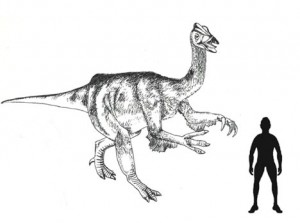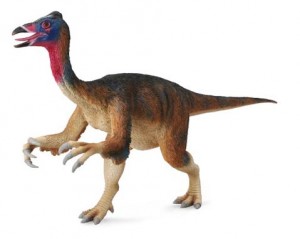Solving the Mystery of “Peculiar Terrible Hand”
Back in November 2013, team members at Everything Dinosaur wrote about of the most intriguing reports to come out of the annual Society of Vertebrate Palaeontology meeting that had just come to an end in Los Angeles. As the dust settled and the researchers made their way home, here was a chance to reflect on the remarkable work done to help finally resolve a fifty year mystery. What type of dinosaur was Deinocheirus?
Huge fossilised forelimbs and shoulder bones, discovered by a joint Polish/Mongolian expedition to the Gobi desert in 1965 had fascinated scientists for nearly half a century. The arms were massive, measuring some 2.6 metres in length (including shoulder blades) and each hand ended in three-fingers, each finger tipped with an enormous, curved claw which in one case was over twenty centimetres long.
Deinocheirus Dinosaur
Based on these huge arms and a few other scraps of fossil bone, most palaeontologists agreed that the fossils represented a giant form of ornithomimid, a member of the “Bird Mimic” group of theropod dinosaurs. Although the arms were much bigger, they did resemble the arms and hands of agile, fast running ornithomimids such as Struthiomimus and Dromiceiomimus. A formal announcement was made about the discovery in 1966, and Deinocheirus “Terrible Hand” was described based on this holotype material in 1970.
This was the cue for every dinosaur book publisher to include a picture of the fossil material in virtually every dinosaur book produced in the seventies and eighties, although very few attempts to illustrate the dinosaur were actually made if we recall correctly.
The Holotype Fossils of Deinocheirus (Deinocheirus mirificus)
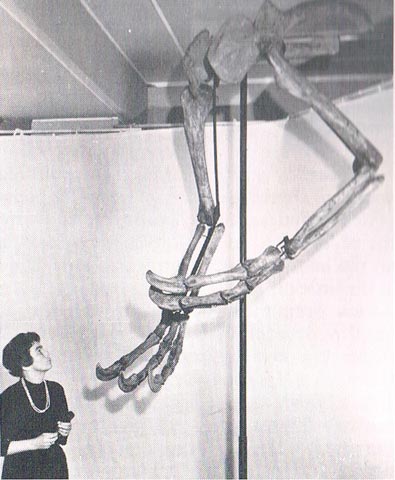
Fearsome arms of Deinocheirus.
Professor Zofia Kielan-Jaworowska
The woman in the photograph is Professor Zofia Kielan-Jaworowska, the scientist who led the 1965 expedition. Although the limbs have been repositioned and remounted since this picture was taken, it does provide a very good impression of the scale of those fossilised limbs.
Writing in the journal “Nature” the scientists behind the paper presented at the conference last year have revealed more about the “enigma” that is the ornithomimosaur Deinocheirus mirificus. Turns out that this bizarre theropod is even more amazing than previously imagined. In the journal, the scientists describe two new specimens of Deinocheirus that were discovered in the same formation (Nemegt Formation) as the original holotype material.
More Complete Fossil Remains
These much more complete fossil remains have enabled the researchers which include Phil Currie (University of Alberta), Yuong-Nam Lee and Hang-Jae Lee (Geological Museum, Korea Institute of Geoscience and Mineral Resources) as well as Pascal Godefroit (Royal Belgian Institute of Natural Sciences), to build up a comprehensive picture of what this dinosaur looked like, where it lived and what it ate.
A New Interpretation of Deinocheirus (D. mirificus)
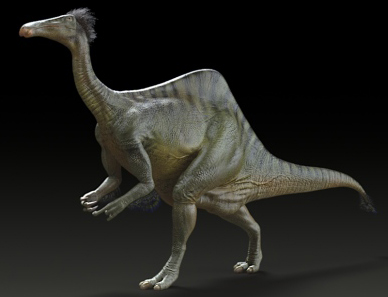
A bizarre looking theropod after all.
Picture credit: Yuong-Nam Lee/Korea Institute of Geoscience and Mineral Resources
It is certainly the largest member of the Ornithomimosauria known to science, with an estimated length of around 11 metres, several tonnes in weight and standing about as tall as a modern-day Giraffe, but it was no vicious super predator. Studies of the feet and hind legs indicate that this animal was probably a slow walker, one with a huge pot belly to boot. A pot belly? This dinosaur had an expanded pelvis with strong muscle attachments. It probably had a large gut to help it digest the tough plant material that it ate.
Edentulous Jaws
The skull measures over a metre in length, but there were no teeth in the deep jaws. Indeed, over a 1,000 gastroliths have been found in association with the fossils, along with fish remains in the body cavity indicating that this animal was probably a mega-omnivore, eating plants, but also insects, small animals and fish.
Deinocheirus lived next to a large river. Seventy million years ago, this part of Mongolia resembled the Upper Nile. The broad, wide toes with their blunt claws were ideally suited to assist this animal when walking over soft mud. It probably wandered into the river to feed on soft water plants, to catch the occasional fish and to avoid the attentions of the tyrannosaur Tarbosaurus. However, evidence that Tarbosaurus fed on Deinocheirus has been preserved on some of the bones.
Scavenged by Tarbosaurus?
Whether or not the bite marks and feeding gouges that have been identified indicate that Tarbosaurus predated on these large bipeds, or whether these marks were made as a result of scavenging a carcase remains unclear. However, the deep, “U-shaped” wishbone of this dinosaur and those big shoulder bones suggest that this ponderous giant could inflict some serious damage should any unwary tyrannosaurid venture too close to those huge arms.
This dinosaur had a number of unique skeletal features, it had a pygostyle (fused vertebrae on the end of the tail), like a bird and a much thicker tail than its smaller ornithomimid relatives. Perhaps one of the most intriguing features are the large number of tall neural spines. The dorsal and sacral vertebrae have flat, blade-like extensions (neural spines). To us, these spatulate spines resemble the bones seen in the humps of Bison.
A Sail-like Structure or Perhaps a Large Hump
Deinocheirus could have had a sail-like structure on its back, or maybe even a large hump. It has been suggested that the hump, originally reported upon in 2013, could have been exaggerated. These neural spines could have supported a network of ossified tendons to help support this dinosaur’s huge gut and heavy tail.
An Illustration of Deinocheirus (D. mirificus)
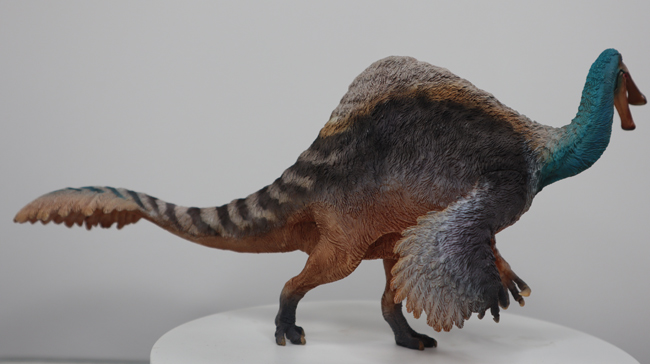
The PNSO Jacques the Deinocheirus dinosaur model has an articulated jaw. Picture credit: Everything Dinosaur.
Picture credit: Everything Dinosaur
To view the PNSO range of dinosaur models: PNSO Dinosaur Models.
Deinocheirus Models
The model making company CollectA introduced a 1:40 scale replica of the mysterious Deinocheirus back in 2012. At the time, we commended them for bringing out a model of this dinosaur when so very little of the total skeleton had been studied and described. With the information regarding the hump, we at Everything Dinosaur amended our scale drawing to give an impression of a small hump over the pelvis, but the latest illustrations really emphasis the hump or sail on this animal’s back.
Ironically, CollectA gave their Deinocheirus model feathers, no evidence of feathers on the original holotype material or indeed on the more recently discovered fossils have been found, but it is thought that a number of ornithomimids were indeed, feathered.
An Illustration of the CollectA Deinocheirus Model (2012)
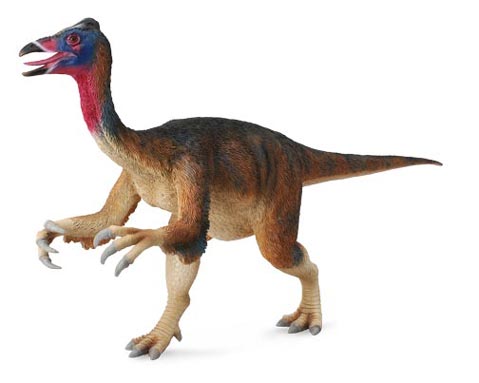
Scientists speculate that Deinocheirus was covered in simple feathers.
As lead author of the scientific paper, Yuong-Nam Lee states the researchers were just as surprised as anyone when they put the complete dinosaur together based on the three main specimens that had been found to date.
Yuong-Nam Lee went on to add:
“The discovery of the original specimen almost half a century ago suggested that this was an unusual dinosaur, but did not prepare us for how distinctive Deinocheirus is. A true cautionary tale in predicting forms from partial skeletons.”
To view Everything Dinosaur’s origin article on this research, published in November 2013: A Helping Hand for Deinocheirus.
To view the range of CollectA scale models available including the 1:40 replica of Deinocheirus: CollectA Deluxe Prehistoric Life Replicas.


